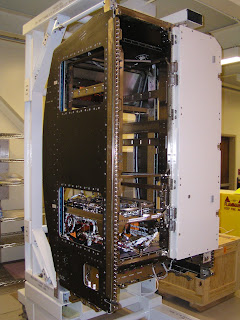Learning How Materials Work in Space to Make Them Better on Earth
 What's about the size of a large refrigerator, weighs a ton and may help pave the way for new and improved metals or glasses here on Earth?
What's about the size of a large refrigerator, weighs a ton and may help pave the way for new and improved metals or glasses here on Earth?It's the Materials Science Research Rack -- a new laboratory on board the International Space Station.
This facility will allow researchers to study a variety of materials -- including metals, alloys, semiconductors, ceramics, and glasses to see how the materials form, and learn how to control their properties. The results from experiments conducted in the facility could lead to the development of materials with improved properties on Earth.
Materials science research is a multidisciplinary endeavor studying the relationships between the processing conditions and properties of materials. The research rack -- measuring 6 feet high, 3.5 feet wide and 40 inches deep -- will provide a powerful, multi-user materials science laboratory in a microgravity, or near weightless, environment. Researchers can benefit from studying materials in space because they can isolate the fundamental heat and mass transfer processes involved that are frequently masked by gravity on the ground.
The research rack will provide hardware to control the thermal, environmental and vacuum conditions of experiments; monitor experiments with video; and supply power and data handling for specific experiment instrumentation.
"Materials science is an integral part of our everyday life," said Sandor Lehoczky, project scientist for the rack at NASA's Marshall Space Flight Center in Huntsville, Ala. "The goal of materials processing in space is to develop a better understanding of how processing affects materials properties without the complication of gravity causing density effects on the processes. With this knowledge, reliable predictions can be made about the conditions required on Earth to achieve improved materials."
The Materials Science Research Rack is an automated facility with two different furnace inserts in which sample cartridges will be processed to temperatures up to 2,500 degrees Fahrenheit. Initially, 13 sample cartridge assemblies will be processed, each containing mixtures of metal alloys. The cartridges are placed -- one at a time -- inside the furnace insert for processing. Once a cartridge is in place, the experiment can be run by automatic command or conducted via telemetry commands from the ground. Processed samples will be returned to Earth for evaluation and comparison of their properties to samples similarly processed on the ground.
 The research rack was launched to the space station aboard space shuttle Discovery on August 28. It was installed in the U.S. Destiny Laboratory Sept. 2. The development of the rack was a cooperative effort between NASA and the European Space Agency. The rack accommodates the European Space Agency’s Materials Science Laboratory -- designed to provide controlled, materials processing conditions and advanced diagnostics. The Materials Science Laboratory has the capability to handle different furnace inserts. Metallurgical research will be conducted in the laboratory to gain a better understanding of industrial metallurgical processes, such as casting, welding and other advanced melting processes.
The research rack was launched to the space station aboard space shuttle Discovery on August 28. It was installed in the U.S. Destiny Laboratory Sept. 2. The development of the rack was a cooperative effort between NASA and the European Space Agency. The rack accommodates the European Space Agency’s Materials Science Laboratory -- designed to provide controlled, materials processing conditions and advanced diagnostics. The Materials Science Laboratory has the capability to handle different furnace inserts. Metallurgical research will be conducted in the laboratory to gain a better understanding of industrial metallurgical processes, such as casting, welding and other advanced melting processes.For more information, visit:



 2:48 AM
2:48 AM
 sheldon
,
sheldon
,















0 Response to "Learning How Materials Work in Space to Make Them Better on Earth"
Post a Comment